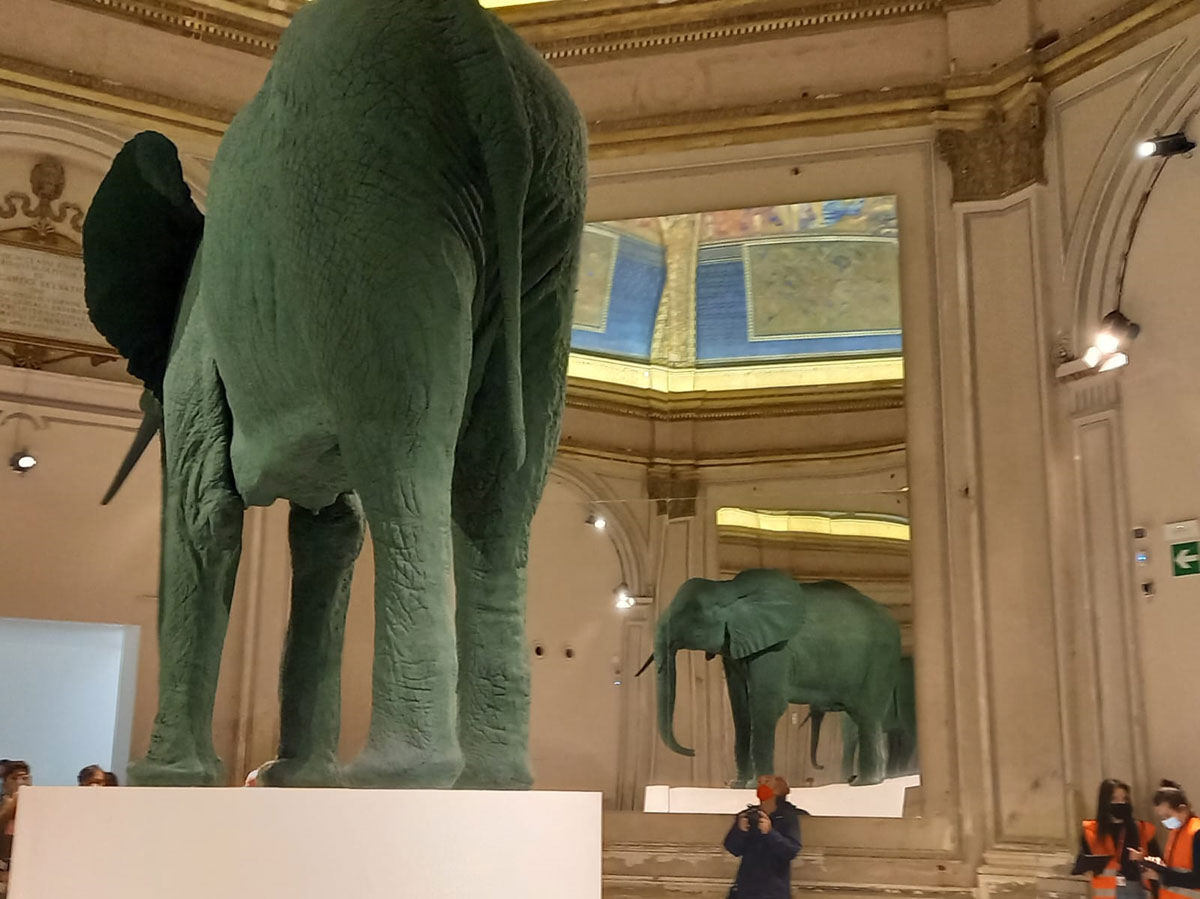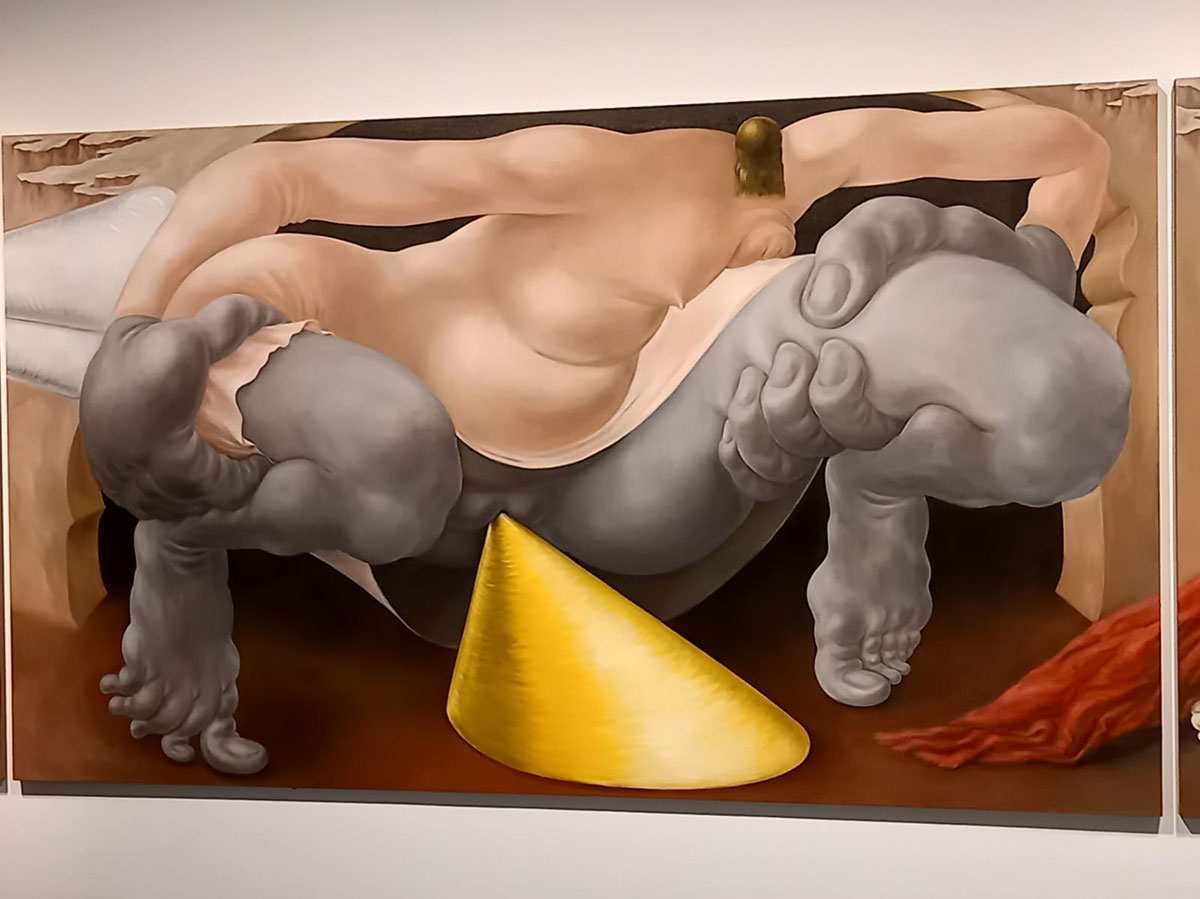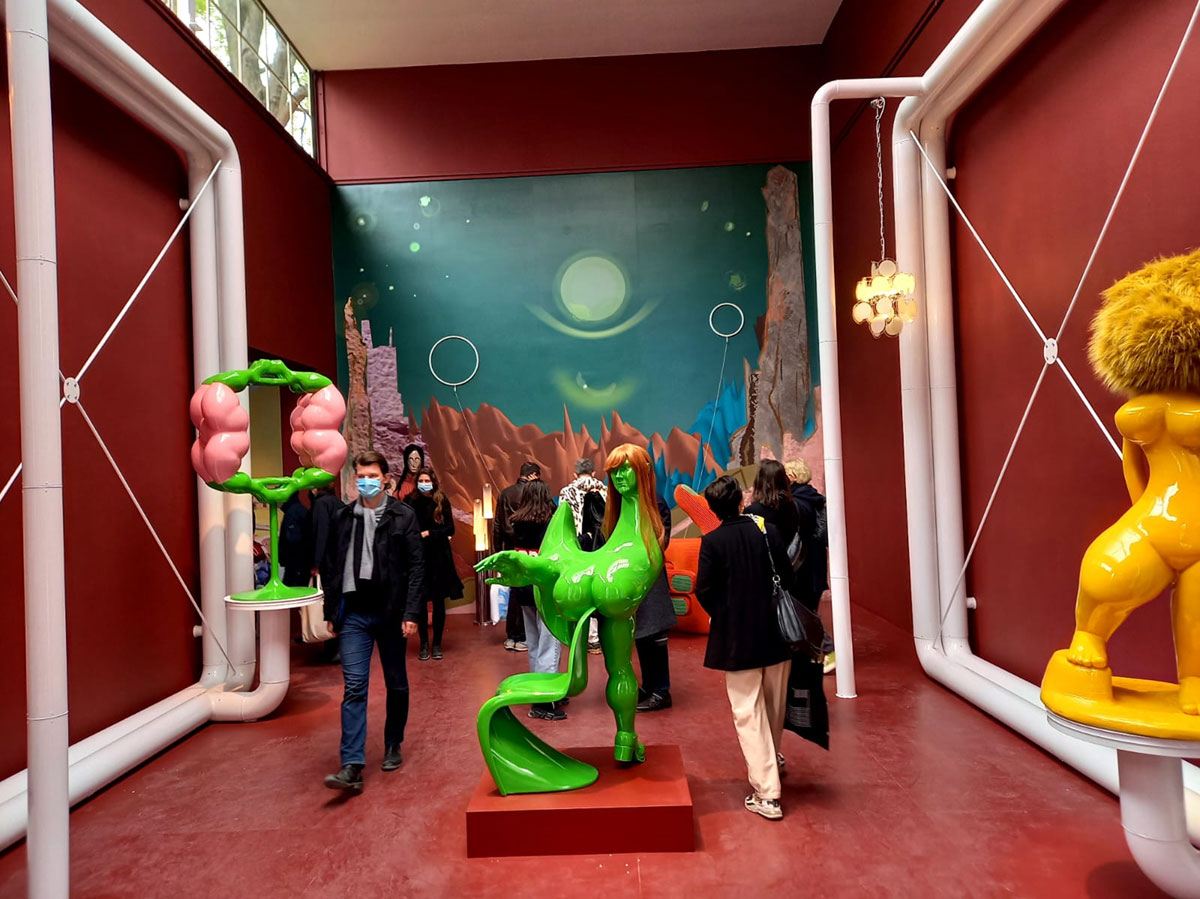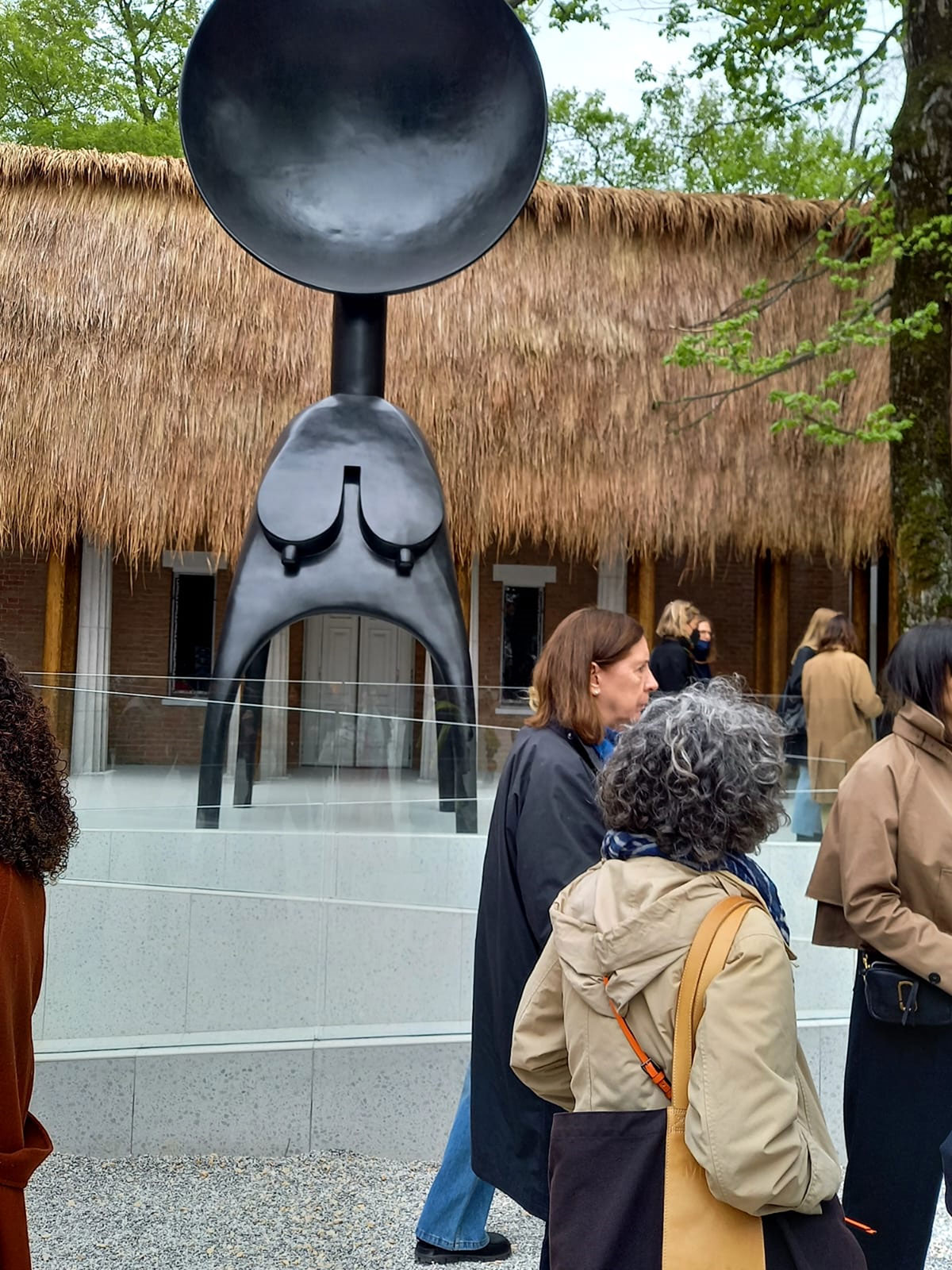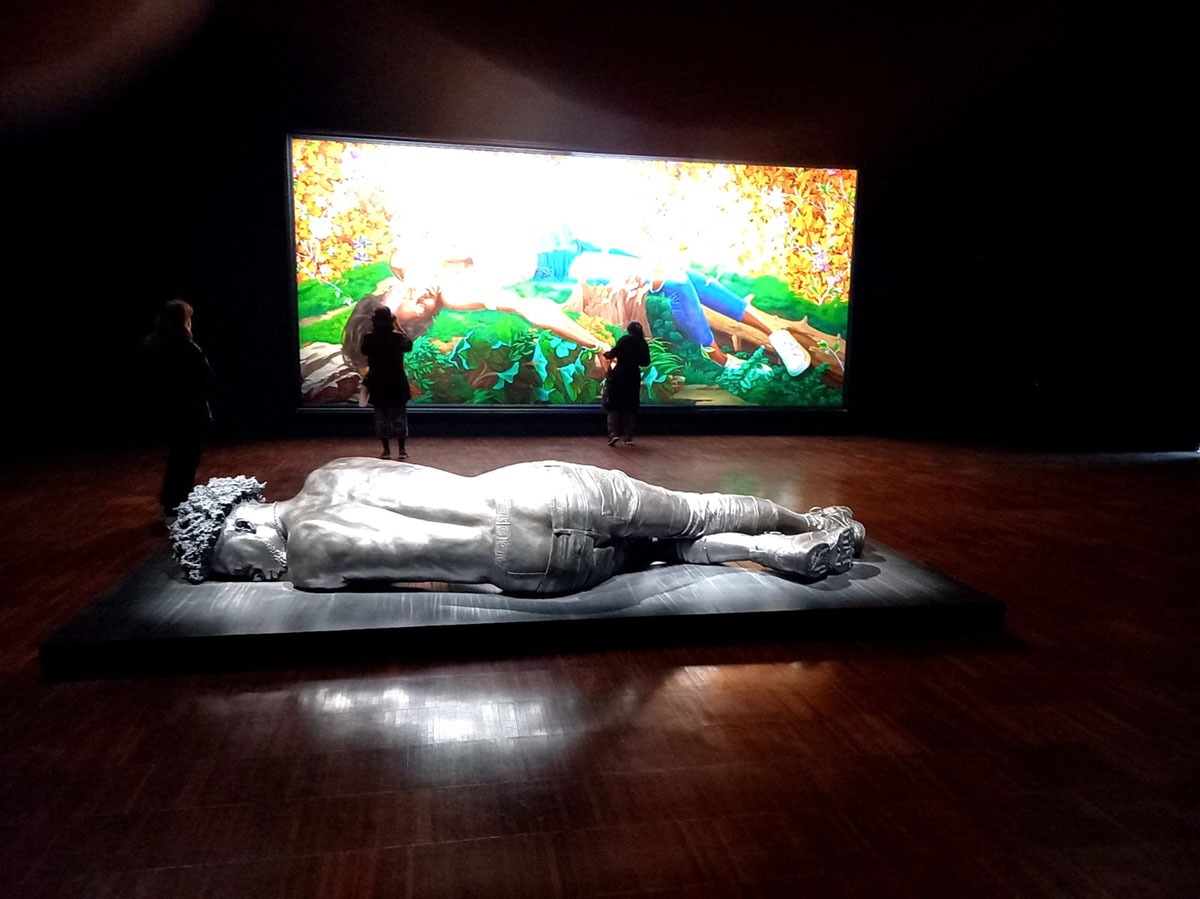I believe there was a question in an Oxford Philosophy Finals Paper, ‘Where is Oxford University?’, which was presumably put to elicit a discussion on what constituted the concept of a university. One could put a similar question, who is responsible for a contemporary art show? An answer would denote several parties, all of them perhaps logically necessary, but none sufficient: artists, and possibly curators, venue owners, funders, and publicists. One could further ask, what does one respond to in said contemporary show, qua show? Is it the show as a composite entity, or the individual works in it, or the last two plus the now-obligatory written curatorial directions, or the context, historical or otherwise, in which it was staged? The matter of curation raises yet another question: how much is a show to be judged as a realisation of some published project (Alemani: 2022a: 33), or simply as a phenomenon which is independent of redaction or authorship?
I do not rehearse these as yet another example of the dry, fingernail-dragging cerebration (or attempted cerebration) which bedevils the contemporary art world; they are the stuff of every would-be spectator’s response to any artistic manifestation. When I first visited a Biennale in 1978 (how it creeps up on you!), video and installation works were still technically basic, small-scale and low-key, the pavilions generally being used as picture gallery spaces. This year only a minority of national pavilions, the Biennale central pavilion and parts of the Arsenale complex could be described similarly. So, the matter of ambience is far more salient than it would have been 44 years ago. Likewise, so far as I remember, the age of the overall uber-curator, more prominent in published material than the exhibitors, had not yet begun. The Arsenale basin was then still a working naval base, and so there was much less non-national pavilion space. Whatever judgements one makes about the exhibitions are both vaguely experiential, but also, nowadays, they have to take more account of the penumbra of words that surrounds them.
This year’s Biennale was entitled The Milk of Dreams, quoting the Surrealist painter and author Leonora Carrington. It was curated by Cecilia Alemani, based in New York. It included over 200 artists from 58 countries, more than 180 of whom had not been shown there previously. For the first time in Biennale history, the majority were women or non-gender conforming. In her introductory essay, Alemani put the question ‘How is the definition of human changing?’, and envisaged such changes as having four potential directions: from the exclusive paradigm of the white male as normative; from the vaunting of masculine Enlightenment ‘rationality’ as characterising human intelligence; from the assumption of the human as transcending and mastering animate and inanimate nature; from the belief that the human body will remain independent of technological instrumentation (Alemani,2022b: 43–45). So, by contraposition, four themes are entailed: at the very least, the admission of non-male normativity; the revisiting of oneiric and intuitionist states of consciousness, and of shamanist and magical practices; the search for new communion and sense of kinship with nature; the countenancing of the possibility of human/machine entwinement, the cyborg. It is certainly a wide-ranging set of proposals on which to base an exhibition, and which themselves are associable with contemporary discussions of the ‘post-human’ condition.
Alemani further punctuated her curated exhibitions with five ‘capsules’ or themed areas. ‘The Witch’s Cradle’ featured historic women Surrealists (Alemani has specialised in this movement). ‘Technologies of Enchantment’ explored Programmed and Kinetic Art from the 1960’s. ‘Corps Orbite’ revisited a pioneering show of Visual and Concrete Poetry at that 1978 Biennale (which, alas, I cannot recall seeing). ‘A Leaf a gourd a shell…’ explored feminine realisations of containers and vessels. ‘Seduction of the Cyborg’ presented historic artistic fusions of human and non-human (Alemani, 2022b: 45–49). Between these capsules were a variety of works by modern and contemporary, mainly female artists.
So, this was what one could call a thoroughly organised and curated show, and one which explicitly had a considerable proportion of historic work. Alemani has admitted that Covid had made it unavoidable to do a lot of the selection from images alone (Alemani 2022a: 31), and this might have affected the intuitive ‘flow’ of works when actually hung in situ. If I can paraphrase my opening questions in slightly Aristotelian terms, there are three standpoints any spectator can take here: that of examining ‘first causes’ or agencies; that of the ‘formal’ entity of the show, and its individual ‘material’ components; that of the ‘final’ causes of curatorial intention and impact (I hope that does not reek of dry masculine pretences to rationality). But first, I will try to give my general impressions and what attracted my attention.
The Central Pavilion at the Giardini is a confusing space to find one’s way around, and resists easy thematic hangs. The assertive works of Katharina Fritsch, Andra Ursuta and Rosemary Trockel were well chosen to begin the tour. But the succeeding capsule ‘The Witch’s Cradle’ could not transcend a rather dry museological presentation. I think several more works by fewer artists would have been more effective. As an admirer of Dorothea Tanning’s later production, I consider she deserved far more, and here, quite relevant, exposure. Jana Euler’s insects and bodies and Christina Quarles’ (somewhat Daniel Richter-like) figural pieces were powerful. But, and it isn’t familiarity that drives me to say this, the room devoted to (the recently dead) Paula Rego reminded me of just what a singular talent she was. There was a kick to her drawing which few contemporaries could muster. The 29 year-old Kudzanai-Violet Hwami created arresting bricolages of images taken on her return to Zimbabwe.
The Corderie of the Arsenale presented a more diverse range of work, of which the following took my attention. The late Belkis Ayon made prints of spectral figures from Cuban folklore. Felipe Baeza devises what could be called multi-media figurative palimpsests. Jamian Juliano-Villani produces brash, beautifully crafted collisions between cartoonland and banal interiors, and, in adjacent mode, Louise Bonnet showed a huge triptych of inflated bodies, almost Stanley Spencer on steroids, but as much grotesque as whimsical. Barbara Kruger and Ozlem Altin both engage with more traditional collage procedures. The late Noah Davis, dead at 32, portrayed back American lives and disappointments, with a sensibility that recalls Dumas and even Doig.
It is evident that I have not mentioned, in the Central Pavilion or the Corderie, any of the other four thematic capsules. This is because, frankly, they did not seem to illuminate the works around them, to the point that one could walk through them without noticing. It was, for me, an over-categorised structure, one in which it was difficult to discern how the latter works conformed to it. And, to return to my three standpoints, the ‘first’ causes of both shows seemed to be to illustrate a written set of theses rather than to create an autonomous presentation which had its own rationale (if that word is not too toxically male). As a result, despite the undoubted qualities of some individual works within it, the ‘formal’ logos of the shows was rather empty; it lacked spectacle. As to the final cause, the curatorial intention, this was explicitly guided by Alemani’s academic interest in feminine Surrealism, but consequently, as a selection of women’s art per se, it was, I think, rather narrow. A disinterested spectator, not knowing this intention, would infer that women tend to produce nicely crafted, whimsically somatic caricatures of their own femininity, in other words, the kind of stereotypical productions that male critics have dismissed in the past. Sheltering from the wretched weather in a restaurant, I got talking to a Roman dealer. When we asked each other to summarise our impressions, it was the same word: ‘conservative’. And he added ‘I’m missing some anger’. Without mentioning names, which might inadvertently reveal an Anglo-American bias, there are plenty of women artists, not exhibited here, who explore far more chthonic, dark corners of the psyche. In these shows, the closest to get to this was Rego.
I have never been sure how much influence the general theme of each Biennale has over the choices made by those running the national pavilions. Are they obliged in some way to tick the boxes, or can they decide to do what they please? This year some seemed to have responded to the majority of women elsewhere by showing instances of what I would call ‘sexy biomorphism’, pendulous forms and folds in a variety of media, reminiscent of female body parts, which apparently derive from Tanning’s innovative cloth sculptures, as continued by Sarah Lucas; this term could comprehend the works presented by Austria, Brazil, Egypt, Hungary, Uruguay and Korea. And the US pavilion, with Simone Leigh’s impressive sculptures, reflected this tendency too, though entwined with references to colonialism and African ritual, to the point of covering its neo-classical colonnade with a grass roofed porch.
The ‘darkening of the age’ to quote Heidegger, cannot, however, be kept out of artistic consciousness. The Russian pavilion, whose artists and curators bravely went on strike at Russia’s disgraceful invasion of Ukraine, stood closed and empty, guarded by three carabinieri. Various protest happenings have occurred outside; I hope they were documented as part of the Biennale. Elsewhere, there were more anthropologically directed, documentary works and installations, as instanced by Belgium, Canada, Finland, Romania, Estonia, France and Israel. One had a sense that some participants conceived their presentations as feints from the intolerant populist nationalism of their present governments, Hungary comes to mind, but also Poland, whose bland textile installations by Malgorzata Mirga-Tas, record Roma people’s life. The Nordic Countries featured perhaps the most accomplished painting of the national pavilions, as part of a multi-sensory installation about the indigenous Sami people. My somewhat synoptic approach to the Giardini pavilions rather reflects the responses, or lack, that they elicited.
It would be good to conclude with the winner of this year’s Leone d’Oro, the UK’s Sonia Boyce, whose exhibition ‘Feeling Her Way’ blended wallpapers, geometric structures and moving image recording black British female vocalists meeting for an impromptu session. Alas, the Curse of the Pre-Booked Entry meant that all slots in the queue were taken. This was the case also with Denmark, Switzerland, and Greece. Considering these were press days, is there not a more efficient way of getting the numbers through quickly, notwithstanding the remaining Covid precautions?
Doing the ‘Collateral Events’ is always a race against time, and one would need almost a week to cover them thoroughly. I would make special mention of Kehinde Wiley’s brooding show An Archaeology of Silence, on S Giorgio, which contained monumental yet tenderly decorative paintings and sculptures of black men killed by police violence in the US. This, in contrast to the tenor of much of the Biennale, demonstrated how ‘anger’ can produce sensuous appearances.
This year in Venice was generally favourably reviewed, and was applauded for committed attempts made to be genuinely inclusive. But I wonder how well present curatorial structures, as they have evolved over the last 30 years, can be open to outsiders. Though Alemani is to be congratulated for exhibiting so many artists new to the Biennale, the results were hardly surprising. I have an increasing sense that the art world urgently needs ‘a separation of powers’: the functions of creation, curation, commerce, state patronage, and criticism should be distinct, and even, at times, mutually antipathetic. Only in that way will this increasingly homogenised (and now utterly financialised) world, become porous to authentic innovation. There was both a symptom and cause of that homogeneity on display at this year’s opening; among the world’s gathered cultural press corps, I saw two black men. One was cleaning the café tables.
Competing Interests
The author has no competing interests to declare.
Author Information
Neil Harvey in an artist and a writer based in Northern Tuscany, Italy.
References
Alemani, Celila, 2022a, ‘Interview’, in The Big Bag Biennale Art Guide, 30–34 (Venice: Venezia News).
Alemani, Celila, 2022b, ‘The Milk of Dreams’, in The Milk of Dream: Biennale Arte 2022, 43–51 (Venice: La Biennale di Venezia, April).
